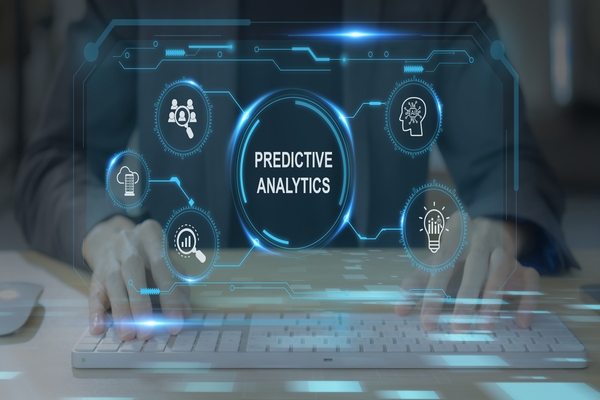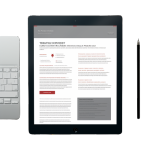
Throughout history, data has been used to enhance decision-making and gain competitive advantages. Today, Big Data is transforming the business landscape by enabling advanced analytics, machine learning and predictive modeling. According to Google Cloud, Big Data refers to massive and rapidly growing datasets—structured, unstructured and semi-structured—that traditional systems cannot manage. Fueled by digital advancements like IoT, AI and mobility, new tools are emerging to help businesses collect, process and analyze data efficiently for better decision-making.
Using statistical algorithms and machine learning techniques such as “predictive analytics” leverages the vast amount of data within “big data” to identify patterns and trends, allowing businesses to forecast future outcomes and make informed decisions based on historical information. By examining historical data, this powerful tool enables organizations to anticipate trends, mitigate risks and optimize decision-making in today’s data-driven world.
While the goals of both predictive analytics and forecasting utilize data to foretell future outcomes, forecasting typically focuses on identifying trends in historical data to estimate prospective values over a relatively long timeframe, while predictive analytics utilizes complex algorithms to analyze various data points, including real-time information, to predict specific future behaviors or events with greater detail and more nuanced insights.
Like airlines, car rental and cruise lines, the lodging industry can benefit from utilizing predictive analytics to optimize guest experiences and operational efficiencies including strategic planning, competition analysis, revenues and yield management, marketing initiatives, preventative maintenance management, energy usage and costs, reputation management and risk management.
Predictive analytics is no different than any other evaluation in that the quality of output is determined by the quality of the inputs which is known as the concept “Garbage in, garbage out.” Several lodging advisory service providers have launched proprietary predictive analytics offerings. Prior to engaging such services, users should consider the offerings historical accuracy. They should also gain confidence in any predictive analytic offering by comprehending the process under which it is premised. A provider who is not entirely transparent with their exclusive methods and techniques should immediately raise a red flag in the eye of the consumer. Since no forecast is ever perfect, confidence in predictions is typically derived from faith in a process and the data utilized. In other words, trust in a process leads to trust in the result.
Users of lodging predictive analytics offerings should consider that an “econometric” model that utilizes quarterly data tends to be more reliable than one that uses monthly data.
Macro data that drives lodging performance should include U.S. census data and U.S. Bureau of Economic Analysis statistical data published on a quarterly basis including national GDP, Corporate Profits, Business Investment, Gross Savings Rates, and Net Foreign Direct Investment. Additionally, property specific surrounding market/submarket statical inputs should include, among other factors, Sector Economic Output, Retail Sales, Household Income Levels, and Housing Construction Starts.
These are the factors that Lodging Analytics Research & Consulting (LARC) leverages in developing its outlook for the U.S. Lodging industry. For 2025, LARC expects U.S. RevPAR to increase by 2.7% to $102.29, driven by ADR growth of 2.7% to $162.85 while occupancy remains at 62.8%. Furthermore, LARC forecasts U.S. Hotel EBITDA to increase 1.1%, with slight margin erosion, and Hotel Values to increase 3% during 2025. Over the next five years, LARC expects Hotel Values to increase by a total of 12%.
December 2024 U.S. Hotel Industry Forecast Summary
| 2025 Growth | 2023-2026 CAGR | 2023-2028 CAGR | ||
| Supply | 0.9% | 0.8% | 0.8% | |
| Demand | 1.0% | 0.8% | 1.0% | |
| Occupancy | 0.0% | 0.0% | 0.2% | |
| ADR | 2.7% | 2.1% | 2.1% | |
| RevPAR | 2.7% | 2.1% | 2.3% | |
| Hotel EBITDA | 1.1% | -0.1% | 0.8% | |
| Hotel Values | 3% | 3% | 2% |
Source: Lodging Analytics Research & Consulting
The below table illustrates a summary of LARC’s current U.S. Hotel Industry Outlook in contrast to last quarter’s outlook. The 2025 outlook is minimally altered from a quarter ago. The most significant change is improving confidence in leisure demand having bottomed out and growth to resume in 2025, which translates into higher occupancy levels but modestly lower ADR growth.
2025 U.S. Hotel Industry Forecast: December 2024 Edition vs. September 2024 Edition
| 12/2024 Update | 9/2024 Update | Outlook Change | |||
| YoY Growth | YoY Growth | ||||
| Supply | 0.9% | 1.2% | -0.3% | ||
| Demand | 1.0% | 0.6% | 0.3% | ||
| Occupancy | 0.0% | -0.6% | 0.6% | ||
| ADR | 2.7% | 3.1% | -0.4% | ||
| RevPAR | 2.7% | 2.5% | 0.3% | ||
| Hotel EBITDA | 1.1% | 1.2% | -0.1% | ||
| Hotel Values | 2.7% | 2.4% | 0.3% |
Source: Lodging Analytics Research & Consulting
LARC’s U.S. RevPAR model has an R-squared of 98.7% within a standard error of 2.7%, back-tested to 2000.
It is important to note that all markets within the U.S. will not align with national averages. Since demand drivers across different trade areas are not the same, forecast model drivers need to be tailored to specific market fundamentals. For example, New Orleans is a market heavily skewed to convention and leisure demand, with limited corporate transient demand. Therefore, the macro-economic factors LARC utilizes for New Orleans forecast include variables such as retail sales, unemployment rate, convention center pacing and special events.
Alternatively, Boston benefits from significant corporate demand and inbound international visitation which results in the following relevant variables Boston Real Gross metropolitan product and office employment, as well as U.S. foreign exchange rates.
Ultimately, predictive analytics enhances business strategy by transforming complex data into actionable insights, but its effectiveness depends on reliable data, sound methodology and industry-specific considerations. As businesses continue to embrace Big Data, leveraging advanced analytics will remain essential for optimizing operations and driving growth.




